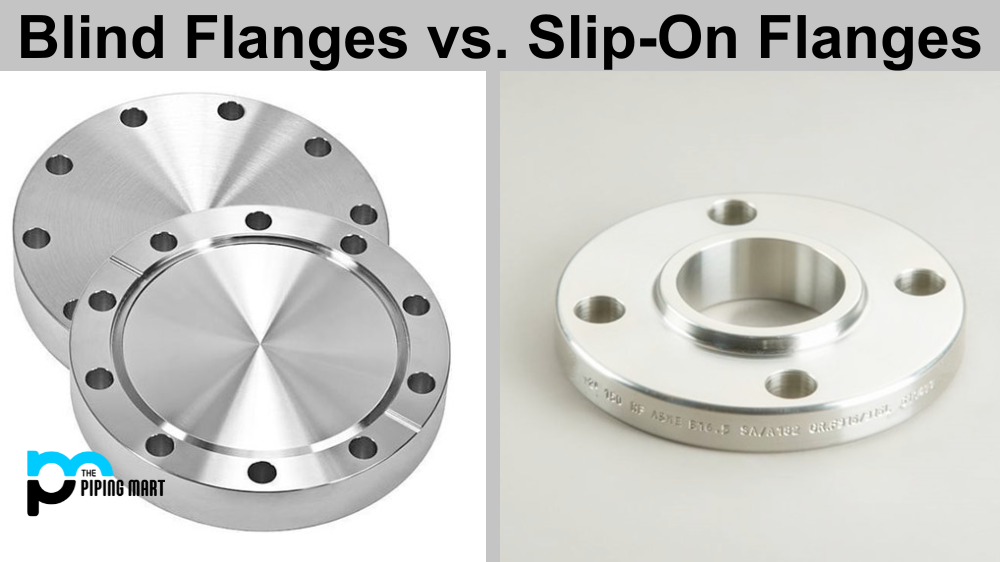In piping systems or pipelines, flanges are essential components that provide a means of joining two sections of pipes or valves together. There are various types of flanges, each with specific applications, making it essential to choose the right flanges for the right application. In this blog post, we will discuss the differences between two common flange types: blind flanges and slip-on flanges. We will also explore how to select the appropriate type of flange based on application and attachment requirements.
What are Blind Flanges?
Blind flanges, also known as blank flanges, are solid disks used to close off the end of a piping system or pressure vessel. Blind flanges are available in different materials and sizes and are often used in applications where it’s not necessary to have a connected pipe, such as at the end of a pipeline or in a vessel’s end. These flanges are commonly installed to close off a pipeline temporarily or permanently.
Types of Blind Flanges and Their Applications
There are two types of blind flanges: flat and raised face. Flat blind flanges are primarily used in low-pressure applications, while raised face blind flanges are used in high-pressure or high-temperature applications. Blind flanges are often used in industries that transport or store hazardous materials such as chemicals, oil, and gas. They are suitable for temporary isolation, testing, or cleaning of a pipeline system.
What are Slip-On Flanges?
Slip-on flanges are one of the most popular types of flanges globally. These flanges slip onto the pipe, allowing for easy installation, disassembly, and maintenance. Slip-on flanges are available in standard and reducing sizes, making them suitable for different pipe diameters. Slip-on flanges are also the least expensive type of flange compared to other types of flanges.
Types of Slip-On Flanges and their Applications
Slip-on flanges are available in different types, such as raised face, flat face, and ring joint. Raised face slip-on flanges are mostly used in low-pressure and high-temperature applications and have a raised lip that surrounds the pipe’s end. Flat face slip-on flanges are used mainly in low-pressure applications and have a flat surface that meets the flange face’s corresponding flat surface. Ring joint slip-on flanges are primarily used in high-pressure and critical applications.
Differences in Applications
Blind flanges and slip-on flanges have different applications. Blind flanges are commonly used in chemical processing, oil refineries, gas plants, and water treatment plants where the pipe or valve needs to be closed off temporarily or permanently. They are also used in pipelines where the end of the pipeline may be extended at a later time. On the other hand, slip-on flanges are used in low-pressure and low-temperature piping systems. They are commonly used in HVAC, refrigeration, and plumbing industries where frequent dismantling of devices is necessary.
Advantages and Disadvantages
Both blind flanges and slip-on flanges have advantages and disadvantages. Blind flanges provide a robust seal, as they are bolted onto the end of the pipe, and are easy to install, making them ideal for temporary or permanent closure of pipes. Slip-on flanges are easy to install, require fewer bolts than blind flanges, and are ideal for low-pressure applications. However, slip-on flanges need to be welded in place, which can weaken the pipe and increase the risk of failure.
Conclusion:
In conclusion, the choice of the right type of flange (blind or slip-on) depends on various factors, such as the piping system’s pressure, temperature, and application requirements. Blind flanges are ideal for applications where a pipeline needs to be temporarily isolated, tested, or cleaned, while slip-on flanges are commonly used in various applications due to their ease of installation and affordability. In selecting the appropriate type of flange, it’s critical to consider the installation and attachment processes and the environmental conditions of the application. Consulting with a piping expert or a flange manufacturer can help you in making an informed decision on selecting the right type of flange for your project.
Sakshee is a talented blogger, with a particular focus on the Business and Metal Industry. She is passionate about sharing her insights on various metal products and helping professionals to make a better decisions.




